Report of analysis by UK schools
The proceedings of the first Higgs Hunters schools conference have just been approved by the ATLAS collaboration!
The students’ results are quite fascinating. They have addressed a very broad range of scientific questions, ranging from “physics” questions about the nature of the collisions, through to the sociological questions about how the biases and experiences of the human citizen scientists might affect the results.
The methods used ranged from large-scale surveys of the images themselves, to analysis of the precision of citizen scientist clicks, and use of highly performant SQL databases and artificial intelligence techniques to store and classify the data.
Congratulations to all the students involved!
You can read more here.
Schools analyse HiggsHunters data
A few video highlights from the first HiggsHunters conference for schools in Oxford
Higgs boson flies off top quarks

Image: Wikipedia
The top is special. It is the heaviest quark by far – more than thirty times heavier than any of the other quarks.
According to the Standard Model, the monsterously heavy top quark should acquire all this mass through its interaction with the Higgs field. The theory tells us that the top is so heavy precisely because it feels the Higgs field more strongly than any other particle.
We can test the theory by making an experimental measurement of the strength of the relationship between the top quark and the Higgs field. To do so we must look at how often a Higgs boson gets spat out when top quarks are produced. This is known as “associated ttH production”, and it has just been measured by the ATLAS experiment at the LHC.
The early results are in and are consistent with expectations – so far. But the uncertainties are very large – about 60% – so there’s plenty of room for something odd to be going on. Any deviations would be very interesting. They might tell us that part of the mass of the top quark came from another source, such as the additional Higgs bosons required by many extensions to the Standard Model.
With more data pouring in all the time, this is a measurement worth keeping an eye on in the future…
What are you talking about?
While the clicks are gathering, and while various people, including schools working with IRIS, are analysing the resulting data, I’ve been starting a study of what’s being discussed on the Talk forum. A wordcloud of the content of the comments already tells us quite a lot…
Unsurprisingly #ocv is the top-ranked hashtag as people indicate they’ve found an off-centre vertex.
As we might expect, citizen scientists use descriptors like “blue” or “white” to describe objects in the images, and then there’s also a good deal of further analysis, with words like “branches”, “center” and “detector”. Clearly some images are hard to interpret as they’re #messy, or otherwise generally a #toughie. Fortunately at least some are “interesting”!
It is great that there’s plenty of particle physics technical talk of “muon”, “quark”. I love even more that the hashtag “#bundle” has developed its own meaning within the HiggsHunters community, even though it’s not one used in the generaly particle physics jargon. Clearly the Zooniverse’s citizen scientists are developing their own technical vocabulary for the images.
So my next job is to go out and understand those new terms…!
First results from your clicks submitted to a journal

Paper submitted to the arxiv preprint server
Over the summer, we put together a paper on the HiggsHunters project and your performance, and it’s now been submitted to a journal and the arxiv preprint server – have a look!
One highlight is a discussion of your ability to identify Off-Centre Vertices compared to reconstruction algorithms, and in a substantial fraction of cases you do a better job! Out of nine different types of simulated “baby bosons”, you outperform the computers for three and come close on a further three. Below is an example of one of the cases where you do best compared to the reconstruction algorithms, with different coloured points representing different ways of clustering your clicks, for example varying N_clicks = the number of you who clicked on a given location. It’s clear you can identify vertices more efficiently (points further to the right) and with fewer false identifications (further down) than the algorithm – marked by a black star – so well done! We also talk about your abilities to spot interesting and unexpected features, for example the muon jet.
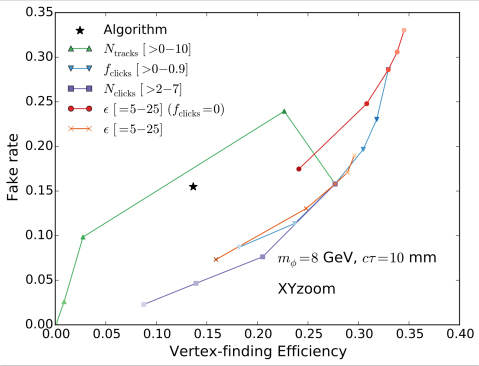
A figure from the paper, comparing vertex-finding abilities of citizen scientists (coloured points and lines) and reconstruction algorithm (black star) for a particular simulation type and image view.
This bodes well for the next steps, where with the help of researchers in schools we’ll further optimise the combination of your clicks and then apply the lessons learned to see what we can uncover in the actual data!
Schools start HiggsHunting
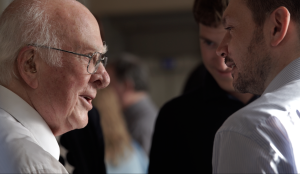
Discussions of the Zooniverse team with Prof Peter Higgs at the HiggsHunters schools launch in Edinburgh
As part of the legacy of the HiggsHunters project, school children in the UK and around the world are being given the chance to search in the HiggsHunters data for new particles.
Getting schools doing cutting-edge research is the brainchild of the amazing school teacher Prof Becky Parker, who has set up the Institute for Research in Schools to bring real search from NASA, CERN and elsewhere to schools.
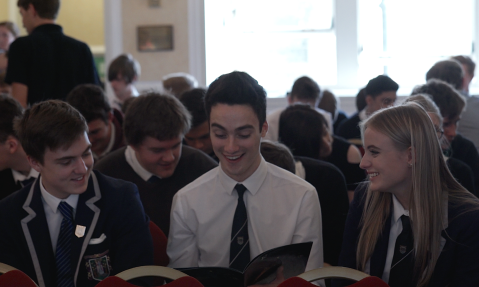 Pupils at the HiggsHunters schools launch
Pupils at the HiggsHunters schools launch
We launched the project to an audience of Scottish school kids and their teachers at the Royal Society of Edinburgh on 16th September. The expert panel answering their questions contained one particularly famous face in the field – Prof Peter Higgs himself.
Happy Birthday to the Higgs Boson!
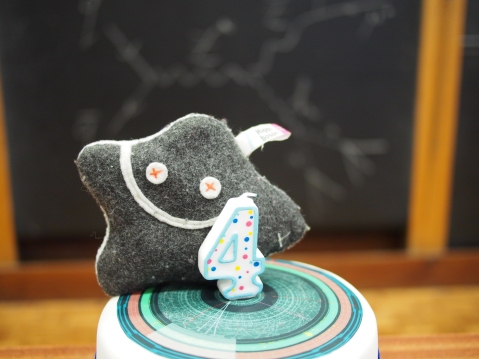
Today we’re helping the Higgs celebrate its fourth birthday!
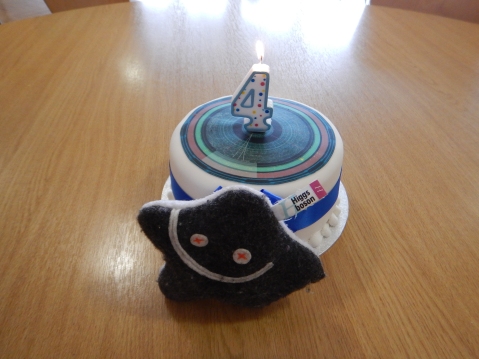
Happy Birthday to you!
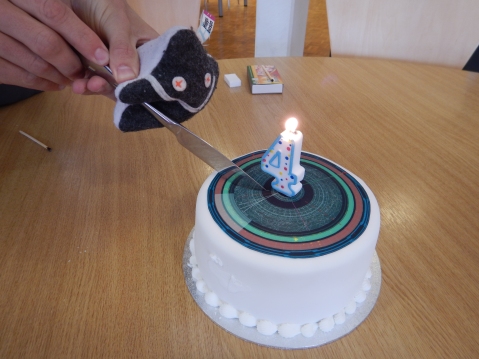
Cutting the cake
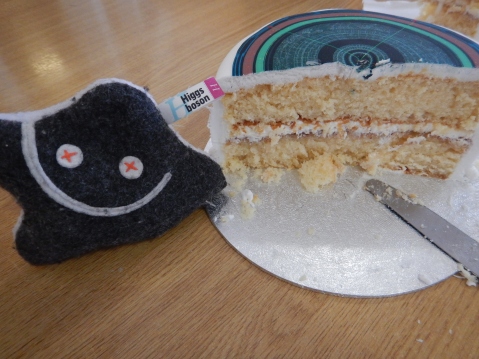
Slice view?

All gone except for a lone muon. Stuffed!
Vertex-finding successes!
Here are a few (of many!) nice examples where you’ve collectively outperformed the reconstruction algorithms to find some Off-Centre Vertices in simulation.
Image 1 – AHH00002qz ‘zoom’
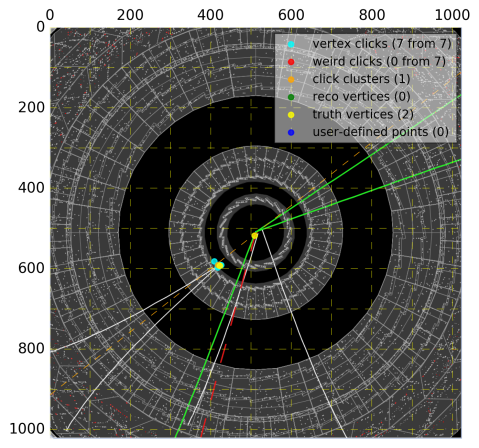
7 clicks from 7 people (marked with pale blue dots) form a cluster (orange dot at (420,590)) right on top of one the ‘truth’ (i.e. real, from simulation) OCVs (yellow dots) – well done!
Image 2 – AHH00002rw ‘normal’
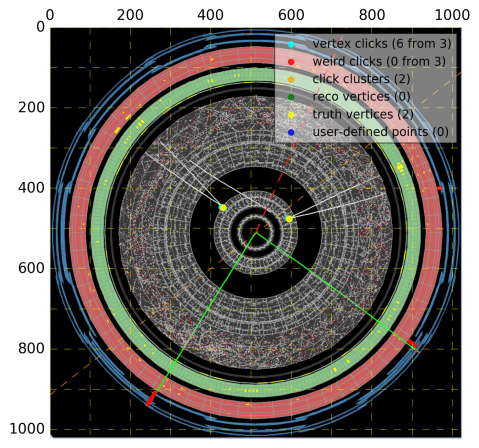
Here 3 people have together identified both OCVs – the orange dots are hidden underneath the yellow ones since they’re spot on!
Image 2 – AHH00006xk ‘slice’
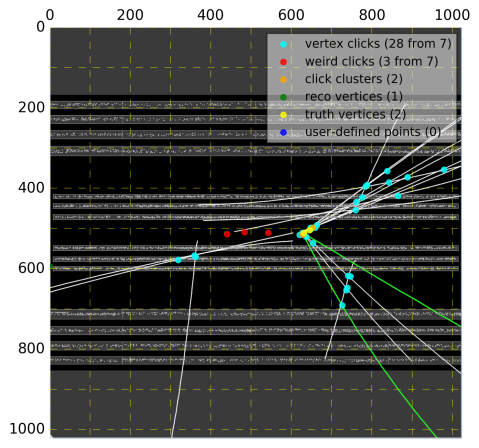
Saving the best for last: a more complicated image, with a few ‘stray’ tracks complicating things. However, when combined the 28 clicks from 7 people form clusters bang on the simulated decay points! As an aside: the ‘weird’ clicks are marking the little coloured dots you often see in slice views – these are completely expected, and show the positions of all the proton-proton collisions that happened at the same time but at different positions along the beam pipe (which runs horizontally across the centre of the image).
It’s great to see you all doing such a good job at finding these OCVs, more analysis to follow!
Analysis time
With the 2016 LHC restart well under way, having successfully recovered from attacks by small mammals (BBC article), it’s time to start analysing your clicks in earnest! Over the past year and a half you’ve made more than half a million classifications (thank you!), and flagged a whole host of interesting features. Over the next few months we’ll be extending the work done by Thomas (e.g. here) on this enlarged dataset to see what we can find out! Stay tuned for more details, and keep on clicking – every image you look at is potentially an as-yet unseen event!
An interesting cosmic ray candidate
Just a quick update today to share this image with you: it’s an image of subject AHH0000kf4, a possible candidate for a cosmic ray. The prominent orange markings, which are present on only a few of the images of this type, are “muon track segments” reconstructed by the detectors. This is slice view, but it looks different to the one you’re used to, which is a zoomed-in and heavily fisheyed version of the central detector – great for detecting any OCVs, but it doesn’t show these particle tracks as well. This was a very striking image, I hope you enjoy it too!
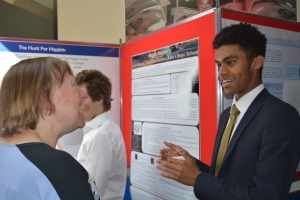
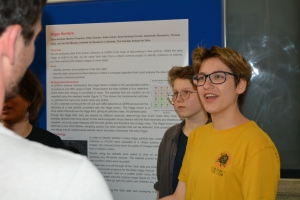
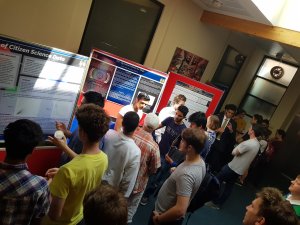
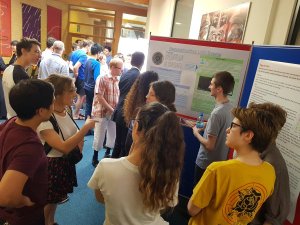

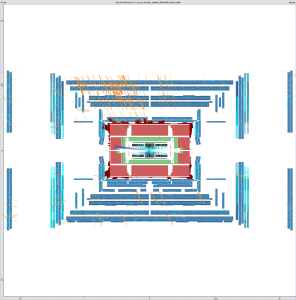
Recent Comments